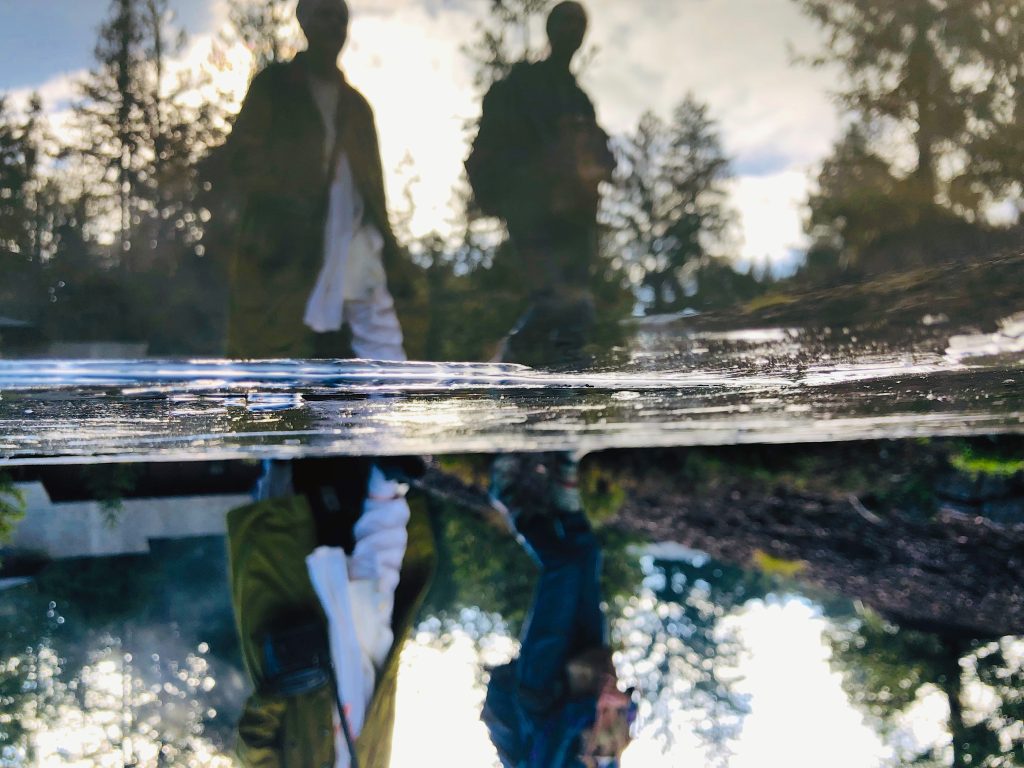By Sat Dharam Kaur ND
One of the questions I may ask a client in a Compassionate Inquiry session is “Who is speaking right now?” or “Who do you think you are in this moment?” The same questions apply to me when I am in the therapist role – “Who in me is speaking to the client?”, “Who do I think I am in this moment?” Am I a teacher, rescuer, advisor, cheerleader, analyzer, explainer, interrogator, fixer, coach, guide, helper or am I simply present with the client in their process? Am I responding to the verbal and non-verbal cues they provide, and open to whatever happens next? We liken the role of the Compassionate Inquiry Practitioner to that of a clear mirror – our task is to mirror to the client what they are revealing to us verbally and through their body language so that they can see, hear and experience themselves directly, not as they pretend to be, but as they are. Our mirroring and inquiry support the client in expressing what is true for them somatically, emotionally and experientially.
Compassionate Inquiry is a relational therapy; healing and transformation happen for both client and practitioner in a relational therapeutic container. It is a two-way mirror. Undoubtedly the client’s issues are in some way my issues as well, and insights and growth occur within me as I work with my clients. The relationship between myself and my client is like a dance – the client leads, and I respond, and this exchange choreographs the session.
Like all relationships, to some degree we recreate one another through our exchange. The way I respond to my client either facilitates opening, healing, insight, expression and clearing, or it doesn’t. Thus, an important question and awareness for me at all times is “How am I showing up? Who am I with this person? What are my triggers and judgements, if any? Do I unconsciously need anything from my client – am I using my client to fulfill my unmet needs?”
The question “Who am I?” has been explored by theologians, philosophers, spiritual teachers, psychologists, writers, neuroscientists, sociologists and physicists. It arises for me during times of transition, when there are shifts in my internal or external world, and a change in roles. At these junctures, I make conscious decisions on where to allocate time and energy, and how I choose to show up in my life. Depending on one’s family, religious and cultural background, training, experiences, attachments, age and perspective, the answer will be different. The answer to the question is itself shaped by one’s subjective identity.
The Merrier-Webster dictionary defines identity as “the distinguishing character or personality of an individual.” Other definitions include “a person’s name and other facts about who they are”; “the fact of being, or feeling, that you are a particular type of person, organization, etc.; the qualities that make a person, organization, etc. different from others”; “the condition of being oneself or itself, and not another” or “Identity is the qualities, beliefs, personality traits, appearance, and/or expressions that characterize a person or a group.” As I read each of these definitions, none of them quite fit my own understanding of who I am.

I agree that I have a name, a personality, an age, a set of beliefs, values, an appearance and a body. However, none of these attributes speaks to the core of ‘who I am’ – instead, they describe something about how I show up in the world, or how others perceive me. My experience of who I am comes closer to the word ‘consciousness’. Consciousness refers to my ability to be present, aware, attentive, discerning, and capable of choosing what thoughts or beliefs to align with, what to say and how to act. Conscious awareness allows me to notice my body sensations, emotions, beliefs and the stories in my mind, and then to decide which to identify with, or act on, and which to disregard.
At any moment, I may act with consciousness or be unconscious. When I am unconscious, presence, awareness and discernment are absent and I act from ignorance, from compulsions, from unconscious biases and beliefs, unmet needs, defence mechanisms, coping strategies, or from habit. When I am conscious, I can utilize my personality traits; pay attention to my body; choose values to live by; align with or question particular thoughts and beliefs; express my authenticity; and fulfill certain roles, recognizing that I am none of these. As a conscious being, I can acknowledge my ignorance; be open and curious; bring awareness to my compulsions and unconscious biases and the hurt they cause to myself and others; and recognize the impact I have on others while in certain roles. When I am conscious, I can be humble, accepting, aware and compassionate.
While the outward manifestation of the body, personality, beliefs, thoughts and values may change over time, consciousness itself is unchanging, ever-present and unattached. It is a much stronger and more accurate anchor for my identity than the body, mind, personality or roles that I play.
Despite this realization, we live in a world of names and forms, where identification with, beliefs,, skin colour, race, gender, sexual orientation,, religion, culture, , and many more external body-based expressions are commonplace. We interpret the world through the senses, particularly sight. Our minds make sense of things through labeling, comparisons, judgements and assumptions. It is this process of the mind that creates division and separation, forms opinions, or believes that it is right: ‘If I am right, then someone else must be wrong.’ We then narrow our view of “who am I?” and limit ourselves when we identify with any of the above categories. We concretize an identity and may lock ourselves into fulfilling a particular role or defending a stance.
On the other hand, the identification with gender, sexual preference, career, race etc. provides the mind and ego structure with security in knowing where we fit, and offers a valuable sense of belonging and attachment. Families and societies are organized around categorizations. The eldest child or male child receives different consideration in many cultures than the youngest child or a female child. When we align with a particular category, we create bonds with those in the same category, we establish a vocabulary, dress code and common understanding that strengthens our identification and sense of belonging within that category, and we often unite with others in our category to improve our lives or the lives of others. We crave the safety experienced in belonging, even if that belonging results in criticism, persecution, oppression or death from those who align with a different set of beliefs or category, such as a religion or political party.
In some situations, this process has led to increasing freedom, equality and acceptance through movements such as women’s rights, gay rights, labour rights, the ‘me too’ movement and Black Lives Matter. Groups, movements and revolutions are needed to generate a powerful voice to propel societal change and topple outdated and oppressive paradigms and structures.
Without identification within categories, it is difficult to imagine how order would be maintained in families, communities, and human society as a whole. How could a political system prevent corruption if there was only one party? How would science move forward if there were not competing theories about what remains unknown? These categories also paradoxically help to shift an existing order when enough people join together to oppose it.
The downside of this is that when we identify with one category, we “other” a different category. We create insiders and outsiders – those who belong to our camp and those who do not. We see differences rather than commonalities, which then can lead to fear, enmity, violence, injustice and war.
Is it possible to accept differences without “othering?” To respect individuals’ freedom of expression, opinions, equality and basic human rights without making them wrong? I believe that it is, but it means that we see others through the lens of compassion, acceptance, humility, curiosity and equality. It also means that we are willing to recognize the privileges and unconscious biases that we carry that oppress others, and that it is our personal and collective responsibility to reduce oppression and work to provide equal opportunities for marginalized individuals or those in the other camp.
This brings me back to the question, “Who am I with my client?” I arrive at the answer that I am both a consciousness that has no fixed identity, as well as the conditioning, perceptions, learning, physicality, sensations, emotions, and sum total of my subjective experiences. Sessions go well when I am aware of both of these perspectives within myself and my client, and can acknowledge and flow between them. How would you answer the question, “Who are you as a therapist?”



